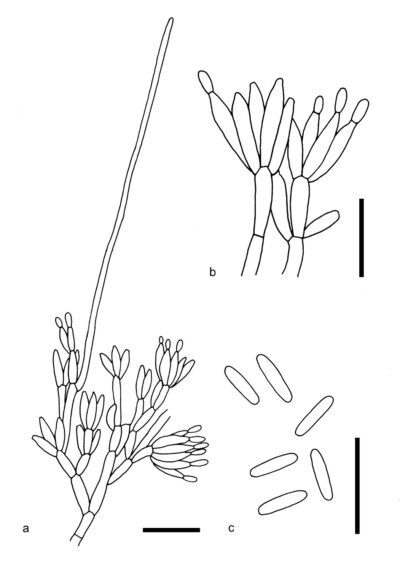Fungalpedia – Note 314, Gregatothecium
Gregatothecium L. Lombard & Crous
Citation when using this entry: Perera et al. 2024 (in prep) – Fungalpedia, genera described in 2016.
Index Fungorum, Facesoffungi, MycoBank, GenBank, Fig. 1
Classification: Stachybotryaceae, Hypocreales, Hypocreomycetidae, Sordariomycetes, Pezizomycotina, Ascomycota, Fungi.
Lombard et al. (2016) established Gregatothecium for a single taxon, that is morphologically similar to Calonectria, Cylindrocladiella and Dematiocladiella (Lombard et al. 2015), but phylogenetically related to Stachybotriaceae in the analysis of cmdA, ITS, rpb2 and tub2 sequences. Gregatothecium can be distinguished from these three genera by its slimy olivaceous-green conidial masses (Lombard et al. 2015, 2016). Gregatothecium produces sporodochial conidiomata consisting of multiple aggregated penicillate conidiophores or is reduced to penicillate or subverticillate solitary conidiophores. Sporodochia are superficially arranged, scattered or gregarious, stromatic and orbicular or irregular in shape. They possess olivaceous green slimy masses of conidia from which hyphal-like setae emerge, although they lack setose fringes. The stroma is weakly developed, hyaline to subhyaline with globulosa and angularis texture. The sporodochial setae arise from the basal stroma, adjacent to cells that give rise to the conidiophore stipes, and are unbranched, straight to flexuous, septate, hyaline, thin-walled, and tapered to an acutely to subobtusely rounded apex. Conidiophore stipes are hyaline to subhyaline, septate, and constricted at the septum with smooth walls. Conidiophores produce several series of aseptate, penicillate branches (up to 6), and are hyaline and smooth-walled, with terminal branches producing 3–6 phialidic conidiogenous cells. Conidiogenous cells are hyaline, cylindrical to subcylindrical, aseptate, straight to slightly curved with minute periclinal thickening, and inconspicuous collarettes. Gregatothecium produces aseptate cylindrical to subcylindrical conidia with rounded ends. Conidia are held in the fascicles of olivaceous green slime (Lombard et al. 2016). However, the sexual morph remains undetermined (Lombard et al. 2016). Gregatothecium humicola has been isolated from coastal soils (Lombard et al. 2016).
Type species: Gregatothecium humicola L. Lombard & Crous
Other accepted species: This genus is monotypic.
Figure 1 – Gregatothecium humicola (CBS 205.96, holotype). a Penicillate conidiophores. b Conidiogenous cells. c Conidia. Scale bars: a = 20 μm, b, c = 10 μm. Redrawn from Lombard et al. (2016).
References
Entry by
Rekhani Hansika Perera, Center of Excellence in Fungal Research, Mae Fah Luang University, Chiang Rai, 57100, Thailand.
(Edited by Kevin D. Hyde, Samaneh Chaharmiri-Dokhaharani, & Achala R. Rathnayaka)
Published online 27 August 2024
